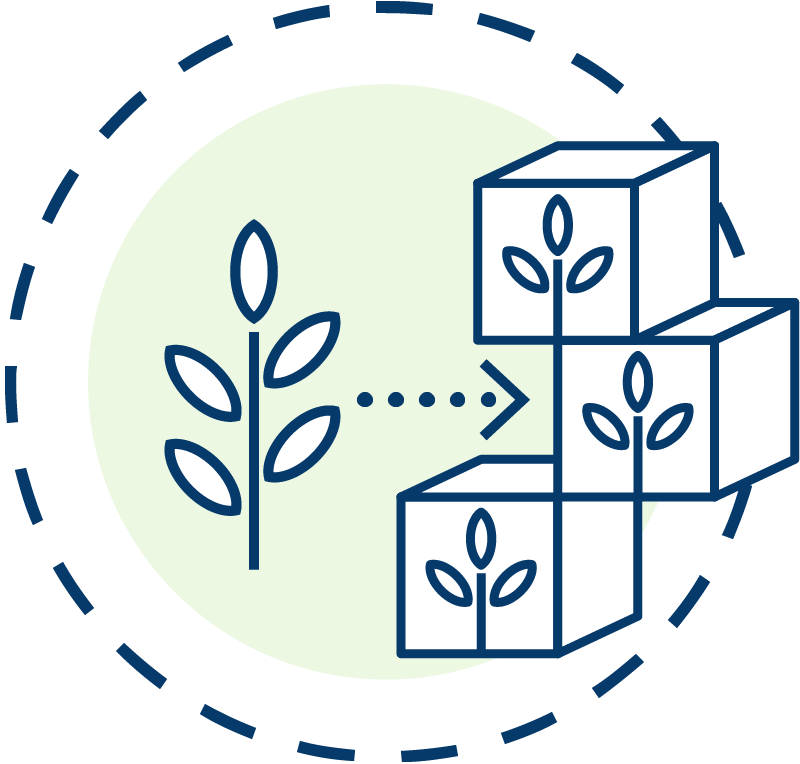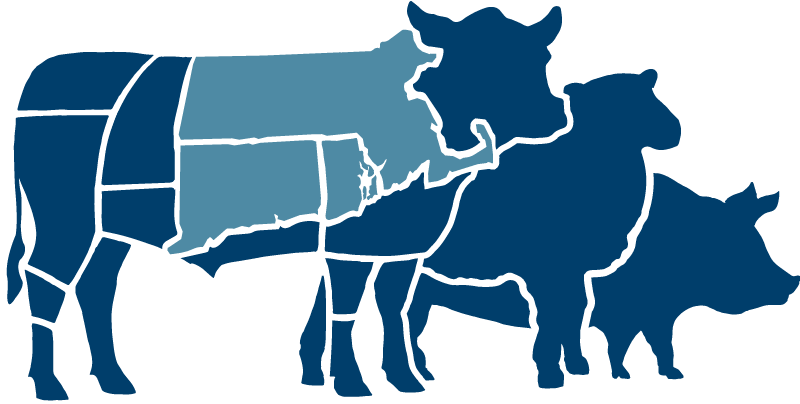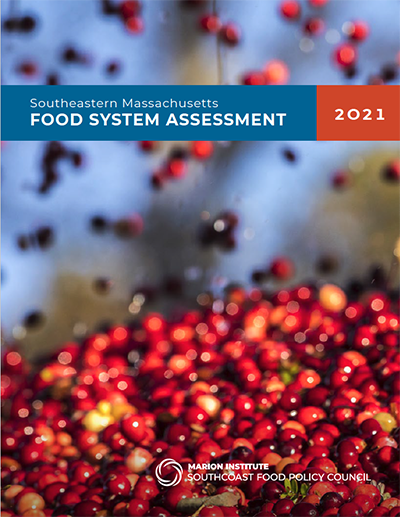Aggregation and Distribution

When we think of food, we do not often think about all the required steps between the farm to our table, such as how meat, fish, fruit, and vegetables have to be transported, processed from raw material, then bottled, canned, packaged, and labeled, before it is shipped to the store.
Since the pandemic, we have seen empty grocery shelves, supply chain disruptions, and our friends and family out of work. According to the United Nations Sustainability Development Goal 8, “Promote Sustained, Inclusive and Sustainable Economic Growth, Full and Productive Employment and Decent Work for All,” our global recovery is slow due to new outbreaks of COVID, rising inflation (cost of everyday items), and supply chain disruptions often due to the inability to hire people. Conflict in other parts of the world and severe droughts and storms adds more stress to this supply chain.

The Food System supply chain comprises farmers, processors, aggregators, distributors, and consumers. This supply chain’s core ‘middlemen’ are the aggregators, processors, and distributors who collect, clean, package, sell and deliver food in bulk. Farmers and fisherfolk rely on the ‘middlemen’ because they do not produce enough food to sell directly to bigger grocery stores and have neither the time nor sometimes the equipment to do this on their own. Buyers – supermarkets, restaurants, and institutional food service providers for schools and hospitals – rely on distributors to help acquire the many foods and ingredients they need to operate and get food to the final consumer. Buyers do not have the time to purchase from hundreds of different farmers and processors to stock their shelves and thus rely heavily on their distributors.
Processing, Aggregation, and Distribution of food in the United States has many components and challenges that impact both human health and environmental health and can also be easily disrupted when one link in the chain is disturbed.
Challenges include:
- Distance to Market – Growing, processing, and transporting food from great distances is needed due to denser populations with little space to farm or produce food, like in metropolitan cities. Northern regions cannot grow food all year which requires procuring food from other parts of the country or overseas.
- Environmental Impact – The processing and packaging of food uses 20% of the US’s fossil fuel consumption. Packaging alone accounts for roughly two-thirds (by volume) of total packaging waste in the United States. Burning the packaging materials in landfills can pollute the air and water and harm the environment and the surrounding communities. The emissions from the transportation of food over great distances are damaging the environment and ourselves.
- Heath Risks from Animal Transportation and Antibiotics – For instance, poultry trucks are very effective at transporting bacteria resistant to antibiotics into surrounding communities. Animals have so many antibodies injected into their bodies that it is hard to find a cure if they get a disease.
- Working Conditions – Another often overlooked sector of the food system, the laborers face significant risks at all stages in the chain, from the farm to the processors to the distributors. For example, workers on large industrial farms with slaughter and aggregation facilities often do not have access to protective equipment and may have limited or no shower facilities to decontaminate themselves between work shifts. Hence, workers face the burden of chemical pesticides and bacterial harm.
- Nutrition – Over time, with the help of food scientists, the industrial food processing industry has refined the tastes, textures, aromas, and colors of food. Processed food requires little preparation and is quick and easy, so many people in our busy society gravitate towards processed food. While some boxed and canned processed food has nutrition, many processed foods also have salts, sugars, and unhealthy ingredients which are toxic to our bodies.
The 2021 Southcoast Food System Assessment shows a strong need for more local food, and thus we require more processors, aggregators, and distributors in this region.
Facilitating the growth of our local supply chain can significantly mitigate the impacts and vulnerabilities of our reliance on a national supply chain. Local food is fresher, tastes better, employs local people, helps the local economy, allows farmers to experiment with crop varieties that are culturally relevant and more nutritious, and there is less transportation impact on the environment and local communities. Southeastern Massachusetts has long been well equipped with large commercial processing houses, broad-line distributors, and wholesale food manufacturers, largely thanks to the massive fish and seafood industry. However, our region does not have many small to mid-size processing facilities, aggregators, or distributors to serve small and mid-size farmers, aquaculture, and small fishing communities.
The good news is that, more recently, our area has developed food system assets in the form of shared commercial kitchens, food hubs, and humane animal slaughter facilities established to accommodate smaller-scale business models, often targeting retail and direct-to-consumer channels. While we still need more of these mid-size and smaller aggregators, processors, and distributors, three critical facilities have been added to the region since 2014 that have significantly impacted regional capacity supporting small and local farmers and producers.

In September 2018, Meatworks opened an 11,000-square-foot USDA-inspected multi-species slaughterhouse and meat processing facility for cattle, hogs, sheep, and goats in Westport, Massachusetts.
The facility has provided processing services to over 400 local and regional producers from Massachusetts, Rhode Island, Connecticut, and New York. The Livestock Institute of Southern New England owns and operates the Meatworks facility, which adds a processing capacity of 5,000 cattle equivalents per year to the region. However, advance reservations of 18 months during the peak of COVID-19 suggest that more capacity is needed if the area is to accommodate sustained scale in the future as part of its food system resilience strategy.
Dartmouth Grange Kitchen (Dartmouth, Massachusetts) and Hope & Main (Warren, Rhode Island), both continuing to serve as the region’s primary commercial kitchens and food incubators, have provided vital processing capacity to the Southcoast. Since opening in 2014, Hope & Main has helped to launch almost 300 businesses and, in 2023, has opened a second location in Providence, RI. Farmers and food producers surveyed in the 2021 Southcoast Food System Assessment (LINK) continue to be interested in commercial kitchen spaces where they can have value-added products made for them or rent time directly to produce one or more food products.

In 2017, local aggregator and distributor Coastal Foodshed (CFS) spun off from Mass in Motion New Bedford is focused on filling Southcoast food access and distribution gaps.
CFS sources locally grown and manufactured products from farmers and food makers and then sells them through three main programs: the New Bedford Farmers Market, the Mobile Farmstand, and the Virtual Market. In 2020, CFS sold more than $340,000 worth of local food directly and indirectly on behalf of more than 50 local farmers and food makers, including processing more than $50,000 in Supplemental Nutrition Assistance Program (SNAP) transactions. A survey of 43 local producers suggests that Coastal Foodshed could continue to expand its food hub services, offering additional aggregation and transportation options to farmers with the potential to channel more locally grown products to wholesale buyers like restaurants and institutions.
Our area has a few great food aggregators, processors, and distributors, but we will need more in the Southeastern part of MA to handle future climate change impacts. New England Feeding New England models of the future food system show that there could be a mass migration of people coming to New England to flee the fires and droughts in the West and Southwest and the flooding in the Southeast. With a pressing need to increase food production and access to locally grown and produced foods, we also need to increase the number of aggregators, processors, and distributors.
Help us to improve regional capacity and infrastructure through your engagement as a Southcoast Food Policy Council (SFPC) member and receive legislative advocacy action by joining our email alert system at sfpc@marioninstitute.org, or donating to the SFPC to keep this community-driven work alive at https://www.marioninstitute.org/donatetosfpc
Resources
- United Nations Sustainable Development Goals
- Johns Hopkins Center for a Livable Future’s online food system educational tool
- The 2021 Southcoast Food System Assessment
- “Introduction to the Food System” certificate from Johns Hopkins University Bloomberg School of Public Health
- Keeve Nachman, Ph. D. Johns Hopkins University Bloomberg School of Public Health
- Neff, Roni (editor). “Introduction to the US Food System: Public Health, Environment, and Equity” Johns Hopkins Center for a Livable Future. 2015 Published by Jossey-Bass.









